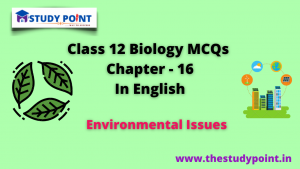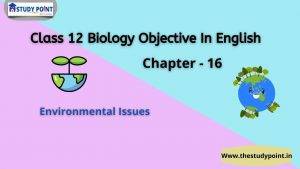Here we are providing Class 12 Biology Objective In English Chapter – 9 Strategies for Enhancement in Food Reproduction include all questions presented in the Biology Class 12 books. Candidates can enlist the help of the Biology Class 12 Objective in English on the next page and gain a deeper understanding of the concepts. Class 12 Biology Objective in English Chapter – 9 Strategies for Enhancement in Food Reproduction is designed by our team of subject matter experts to help students prepare for exams. English students can view the PDF of the Class 12 Biology Objective on the page below. From the Biology Book English Questions and Answers on this page, students will learn how to correctly solve problems.
Remember that the Class 12 Biology Book Objective is the best resource for a good study of the 16 chapters. Use the Class 12 Biology Book Objective as a reference and keep practicing with the answers to questions and exercises until you improve your answers to all chapters of your Class 12 Biology Program. Class 12 Biology Objective in English Chapter – 9 Strategies for Enhancement in Food Reproduction will help you solve all Class 12 Biology questions chapter 9 smoothly. if you want more notes for various subject then click here
Class 12 Biology Objective In English Chapter – 9 Strategies for Enhancement in Food Reproduction
1. Pisciculture is related culture of
( A ) Aquatic plants
( B ) Aquatic animals
( C ) Silk worm
( D ) Lac worm
Ans-( B )
2. Taichung is a variety of
( A ) Rice
( B ) Wheat
( C ) Maize
( D ) Sugarcane
Ans-( A )
3. An infertile plant hybrid can be madefertile by :
( A ) colchicine treatment
( B ) polyploidy
( C ) ganoson treatment
( D) all correct
Ans-( D )
4. The inbreeding between closelyrelated organisms :
( A ) reduces variations
( B ) increases variations
( C ) reduces dominance
( D ) none
Ans-( A )
5. Somaclonal variations are :
( A ) Variations produced in tissue culture
( B ) Variations produced during sexual reproduction
( C ) Variations caused by mutagens
( D )Variations caused by gamma rays.
Ans-( A )
6. In Maize, hybrid vigour is obtainedby :
( A ) Inducing mutations
( B ) Crossing two inbreed lines
( C ) Bombarding seeds with DNA
( D ) Harvesting seeds from most productive plants
Ans-( B )
7. Which of the following nematodesinfect the root of tobacco plants?
( A ) Bacillus thuringiensis
( B ) Cry IAC
( C ) Meloidogyne incognita
( D ) Both A & B
Ans-( C )
8. ‘Sona Lika’ and ‘Kalyan Sona’ arehigh yielding disease resistant variety of
( A ) Rice
( B ) Wheat
( C ) Maize
( D ) Cotton
Ans-( B )
9. The toxic protein secreted by Bacillusthuringiensis is
( A ) Tubulin
( B ) Insulin
( C ) Cry Protein
( D ) All of these
Ans-( C )
10. Green revolution is mainly concernedwith :
( A ) Maize
( B ) Sugarcane
( C ) Fish
( D ) Wheat
Ans-( D )
11. Maize is generally rich in :
( A ) Thiamine
( B ) Lysine
( C ) Methionine
( D ) Cysteine
Ans-( D )
12. Which one is the example of Petroleum plants in the following:
( A ) Euphorbia
( B ) Jatropha
( C ) Hevea & Calotropis
( D ) All
Ans-( D )
13. White rust of wheat is caused by
( A ) Puccinia
( B ) Albugo
( C ) Ustilage
( D ) Cystopus
Ans-( A )
14. Which of the following is an exampleof a cross-breed?
( A ) Mule
( B ) Hilsa
( C ) Hisardale
( D ) Sahiwal
Ans-( C )
15. Jaya and Ratna are varieties of
( A ) Wheat
( B ) rice
( C ) mustard
( D ) pea
Ans-( B )
16. MOET is related to :
( A ) transfer of super embryo
( B ) transfer of super eggs
( C ) super ovulation and embryo transfer
( D ) None
Ans-( C )
17. A plant cell without cell wall is called
( A ) proplast
( B ) protoplast
( C ) nucleoplasm
( D ) explant
Ans-( B )
18. A fungal disease of Poultry is
( A ) coccidiosis
( B ) coryza
( C ) aspergillosis
( D) Mark’s disease
Ans-( C )
19. Ranikhet disease in Poultry is a
( A ) Viral disease
( B ) Bacterial disease
( C ) Fungal disease
( D ) none
Ans-( A )
20. Which in the following is an improvedvariety of chicken ?
( A )Jersey
( B ) Leghorn
( C ) Himgiri
( D ) Kalyansona
Ans-( B )
21. Which disease is found in hen ?
( A ) Smut
( B ) Cholera
( C ) Both A & B
( D ) Ranikhet
Ans-( D )
22. Norman Borlaug is associated with:
( A ) White revolution
( B ) Green revolution
( C ) Blue revolution
( D ) Yellow revolution
Ans-( B )
23. In callus culture, rooting can be induced by :
( A ) Gibberellin
( B ) Cytokinin
( C ) Auxin
( D ) Ethylene
Ans-( C )
24. Borlaug developed new varieties of:
( A ) Wheat
( B ) Rice
( C ) Sugarcane
( D ) Mango
Ans-( A )
25. Virus free plants can be obtainedby :
( A ) Embryo rescue
( B ) Meristem culture
( C ) Protoplast culture
( D ) Anther culture
Ans-( B )
26. Coccidiosis in poultry is caused by:
( A ) Protozoan parasites
( B )Nematode parasites
( C ) Viruses
( D ) Tapeworms
Ans-( A )
27. Which of the following is a freshwater
food fish ?
( A ) Harpodon
( B ) Cichina mrigala
( C ) Anguilla
( D ) Hilsa
Ans-( B )
28. Which species of honey bee in commonly domesticated and cultured?
( A ) Apis indica
( B ) Apis millipera
( C ) Apis dorsata
( D ) Apis florea
Ans-( A )
29. Workers of Honey bee are :
( A ) Fertile male
( B ) Sterile male
( C ) Fertile female
( D ) Sterile female
Ans-( D )
30. Honey is made by
( A ) male honey bee
( B ) queen honey bee
( C ) worker honey bee
( D ) Both (A) & (B)
Ans-( C )




